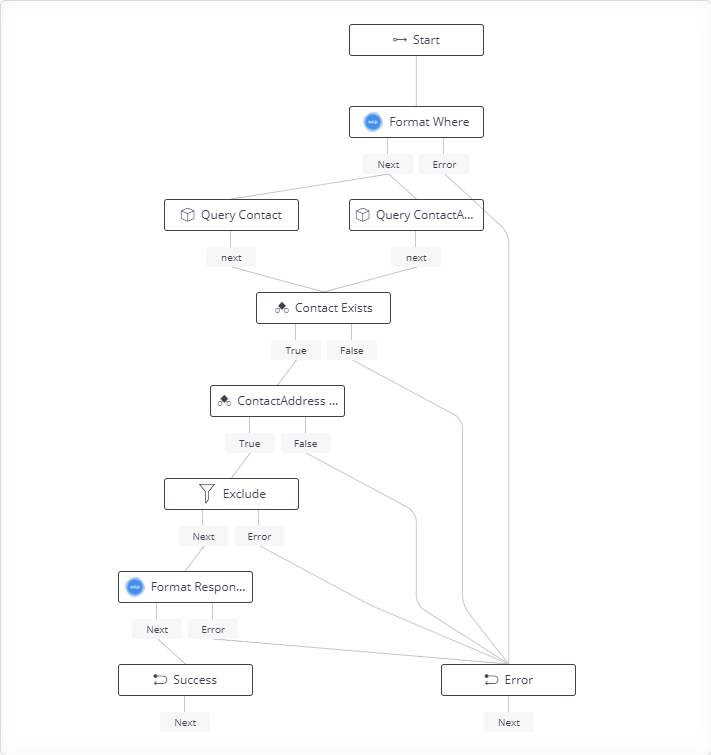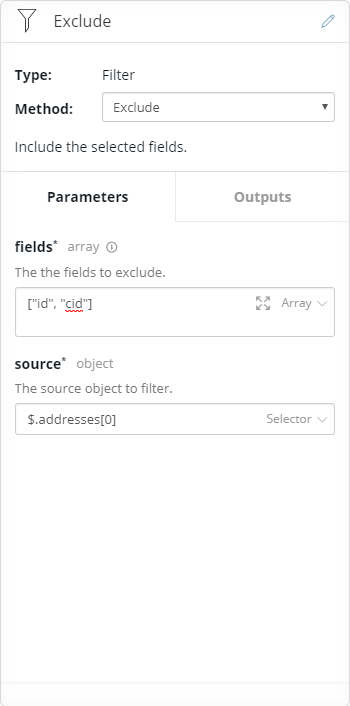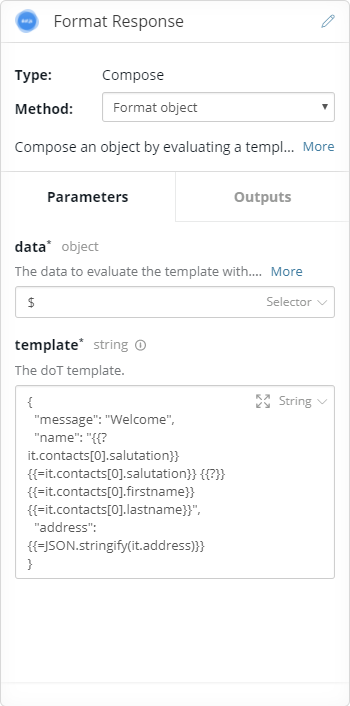Apart from the model nodes, API Builder only ships with a handfull of nodes.
It may seem that this may limit the complexity of flows that can be created. However API Builder is extensible, using the Axway Flow SDK users can create their own nodes to meet their own requirements.
The observant might have notice that in the previous exercise the address had an additional id field, perhaps this is undesirable.
{
"message": "Welcome",
"name": "Mr. Bruce Wayne",
"address": {
"id": "5a15679493e7370284001471",
"cid": "batman",
"address1": "Wayne Manor",
"address2": "107 Mountain Drive",
"city": "Gotham City",
"state": "New York",
"country": "USA",
"postalcode": "0"
}
}
There are many ways to achieve this but for this example we'll create a node that clones an object but can filter the fields in the object. Then we'll update the flow to use this node to exclude the id from the address.
The SDK is published to NPMJS and can be installed with:
w:\training\04_FlowSDK> npm install -g axway-flow-sdk
...
w:\training\04_FlowSDK> axway-flow
Usage: axway-flow [options]
Options:
-n, --name The name of the flow-node, e.g. "base64".
-d, --description Description of the flow-node handler (optional).
-h, --help This usage.
The axway-flow command can now be used to create a node project.
axway-flow -n gm-objectfilter
This will create a project called nodehandler-gm-objectfilter.
The generated project comes with ready to build to make editing it much more intuitive. To start install the dependencies.
npm install
For this node there are no additional depenedency requirements but if there were they could be installed with npm install -S <name>. The basic node project has 3 pieces - the node specification in index.js, the node implementation in action.js and the the tests in test.
Our example scenario requires a method that takes an object and a list of field names and outputs an object. For demonstration purposes we'll have two methods one that includes the specified fields and one that excludes them.
Name and description.
flownodes.add('gm-objectfilter', {
name: 'Filter',
icon: 'icon.svg',
description: 'Filter the object fields.'
});
Include Method
flownodes
.method('include', {
name: 'Include',
description: 'Include the selected fields.'
})
.parameter('source', {
description: 'The source object to filter.',
type: 'object'
})
.parameter('fields', {
description: 'The the fields to include.',
type: 'array',
items: {
type: 'string'
}
})
.output('next', {
name: 'Next',
context: '$.filtered',
schema: {
type: 'object'
}
})
.output('error', {
name: 'Error',
context: '$.error',
schema: {
type: 'string'
}
})
.action(action.include);
Exclude Method
flownodes
.method('exclude', {
name: 'Exclude',
description: 'Exclude the selected fields.'
})
.parameter('source', {
description: 'The source object to filter.',
type: 'object'
})
.parameter('fields', {
description: 'The the fields to exclude.',
type: 'array',
items: {
type: 'string'
}
})
.output('next', {
name: 'Next',
context: '$.filtered',
schema: {
type: 'object'
}
})
.output('error', {
name: 'Error',
context: '$.error',
schema: {
type: 'string'
}
})
.action(action.exclude);
Node the flownodes here follows a builder pattern and these are all chainable, they're just being broken down here for readbility.
One thing to be careful of here that is not obvious is that the object returned by query is not plain data object, it has a custom toJson method that converts it to a plan data object. So to handle models aswell as other object be sure to stringify/parse the source object first.
function filter(req, include, cb) {
const source = req.params.source;
const fields = req.params.fields;
if (!source || typeof source !== 'object') {
return cb.error(null, 'Invalid source, object required.');
} else if (!fields || !Array.isArray(fields)) {
return cb.error(null, 'Invalid fields, array required.');
}
// JSON cloning to work with models better.
const obj = JSON.parse(JSON.stringify(source));
Object.keys(obj).forEach(field => {
if ((!include && fields.includes(field))
|| (include && !fields.includes(field))) {
delete obj[field];
}
});
cb.next(null, obj);
}
function include(req, cb) {
filter(req, true, cb);
}
function exclude(req, cb) {
filter(req, false, cb);
}
exports = module.exports = {
include,
exclude
};
Note also the usage of the callback cb. The callback has methods on it matching the outputs defined in index.js, in this case error and next. So cb.error is triggering the output named error:
return cb.error(null, 'Invalid source, object required.');
Whereas cb.next is triggering the output named next:
cb.next(null, obj);
The default icon is just a star:
Update this with something more appropriate to the node. This will currently be displayed at 28x28px so ensure it looks acceptable at that resolution.
For testing purposes it's often useful to build the module locally and install the built module. To build the module:
npm run build
npm pack
Install the nodehandler into the Welcome app.
w:\training\04_FlowSDK\welcome>npm install -S ..\nodehandler-gm-objectfilter\nodehandler-gm-objectfilter-1.0.0.tgz
The restart the server and open the Welcome flow http://localhost:8080/console/project/flows/welcome-Welcome/edit.
The new Filter node is now present in the tool panel.
To share just publish to npmjs (or give someone the pack): https://www.npmjs.com/package/nodehandler-gm-objectfilter
To install:
npm install -S nodehandler-gm-objectfilter
The goal is to update the flow so that the filter node is inserted before the Format Response and have it strip out the id field from the address.
Type: Filter
Method: Exclude
The new extension node that is going to filter out the fields we don't want.
The node takes $.addresses[0] as the source object and removes cid and id from it. The filtered object is saved as $.address so the Format Response node also needs to be updated for the change.
Type: Compose
Method: Format object
Change from $.addresses[0] to $.address in the template:
{
"message": "Welcome",
"name": "{{?it.contacts[0].salutation}}{{=it.contacts[0].salutation}} {{?}}{{=it.contacts[0].firstname}} {{=it.contacts[0].lastname}}",
"address": {{=JSON.stringify(it.address)}}
}
Save the updated flow and test the API using the Test API panel. The address in the result should no longer have cid or id.
{
"message": "Welcome",
"name": "Mr. Bruce Wayne",
"address": {
"address1": "Wayne Manor",
"address2": "107 Mountain Drive",
"city": "Gotham City",
"state": "New York",
"country": "USA",
"postalcode": "0"
}
}





